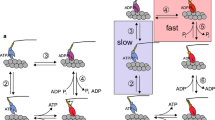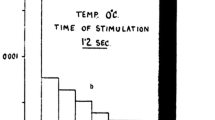Abstract
The substrate concentration dependence of isometric tension transients in response to a quick stretch and release of glycerinated muscle fibers was studied during the first few seconds with a time resolution of sub-milliseconds. Observed tension transients apparently comprise five rate processes, which are named process (1), (1’), (2), (3) and (4) in order of fast to slow. It was found that they might be classified into two groups: one is composed of processes (1), (1’) and (4) and the other of processes (2) and (3). The processes belonging to the first group give a symmetric response with respect to the direction of the length change such that not only the rate but also the fraction of the processes are about the same in magnitude for stretch and release. However, this is not the case for the processes belonging to the second group, which give an asymmetric response. In addition, the rate of the processes belonging to the second group depends on substrate concentration while the rate of those belonging to the first group does not when substrate concentration is higher than a few tens of micro-molar. The symmetric processes are attributed to mechanical changes in the property of cross-bridge whereas the asymmetric ones to those accompanying chemical changes. The early tension recovery phase is comprised not only of processes (1) and (1’) but also of (2) whose rate is proportional to substrate concentration and the square of substrate concentration for stretch and release, respectively.
Access this chapter
Tax calculation will be finalised at checkout
Purchases are for personal use only
Preview
Unable to display preview. Download preview PDF.
Similar content being viewed by others
References
Abbott, R.H. and Steiger, G.J. (1977). Temperature and amplitude dependence of tension transients in glycerinated skeletal and insect fibrillar muscle. J. Physiol. 268: 13–42.
Arata, T., Mukohata, Y. and Tonomura, Y. (1977). Structure and function of the two heads of the myosin molecule. VI. ATP hydrolysis, shortening and tension development of myofibrils. J. Biochem. 82: 801–812.
Chaen, S., Kometani, K., Yamada, T. and Shimizu, H. (1981). Substrate-concentration dependences of tension, shortening velocity and ATPase activity of glycerinated single muscle fibers. J. Biochem. 90: 1811–1621.
Cooke, R. and Bialek, W. (1979). Contraction of glycerinated muscle fibers as a function of the ATP concentration. Biophys. J. 28: 241–258.
Cox, R.N. and Kawai, M. (1981). Alternate energy transduction routes in chemically skinned rabbit psoas muscle fibers: a further study of the effect of MgATP over a wide concentration range. J. Mus. Res. Cell Motil. 2: 203–214.
Eisenberg, E., Hill, T.L. and Chen, Y. (1980). Cross-bridge model of muscle contraction: Quantitative analysis. Biophys. J. 29: 195–227.
Ferenczi, M.A., Goldman. Y.E. and Simmons, R.M. (1979). The relation between maximum shortening velocity and the magnesium adenosine triphosphate concentration in frog skinned muscle fibres. J. Physiol. 292: 71–72 P.
Ford, L.E., Huxley, A.F. and Simmons, R.M. (1977) Tension responses to sudden length change in stimulated frog muscle fibres near slack length. J. Physiol. 269: 441–515.
Heini, P., Kuhn, H.J. and Ruegg, J.C. (1974). Tension responses to quick length changes of glycerinated skeletal muscle fibers from the frog and tortoise. J. Physiol. 237: 243–258.
Huxley, A.F. (1973). A note suggesting that the cross-bridge attachment during muscle con-traction may take place in two stages. Proc. R. Soc. B 183: 83–88.
Huxley, A.F. (1974). Muscular contraction (review lecture). J. Physiol. 243: 1–43.
Huxley, A.F. and Simmons, R.M. (1971). Proposed mechanism of force generation in striated muscle. Nature, Lond. 233: 533–538.
Huxley, H. (1969). The mechanism of muscular contraction. Science, N.Y 164: 1358–1366.
Inoue, A., Takenaka, H., Arata, T. and Tonomura, Y. ( 1970. ) Functional implications of the two-headed structure of myosin. Adv. Biophys. 13: 1–194.
Julian, F.J. and Morgan, D.L. (1981). Variation of muscle stiffness with tension during tension transients and constant velocity shortening in the frog. J. Physiol. 319: 193–203.
Julian, F.J., Sollins, K.R. and Sollins, M.R. (1974). A model for the transient and steady-state mechanical behavior of contracting muscle. Biophys. J. 14: 548–562.
Kawai, M. (1978). Head rotation or dissociation? A study of exponential rate processes in chemically skinned rabbit muscle fibers when MgATP concentration is changed. Biophys. J. 22: 97–103.
Kawai, M. and Brandt, P.W. (1980). Sinusoid analysis: a high resolution method for correlating biochemical reactions with physiological processes in activated skeletal muscles of rabbit, frog and crayfish. J. Mus. Res. Cell Motil. 1: 279–303.
Marston, S.B. and Tregear, R.T. (1974). Nucleotide binding to myosin in calcium activated muscle. Biochem. Biophys. Acta 333: 581–584.
Nakagawa, T. and Oyanagi, Y. (1980). Program system experimental sciences. In: Recent Developments in Statistical Inference and Data Analysis, pp. 221–225, ed. Matusita, K. Amsterdam, New York and Oxford: North-Holland Publishing Company.
Nishiyama, K., Shimizu, H., Kometani, K. and Chaen, S. (1977). The three-state model for the elementary process of energy conversion in muscle. Biochem. Biophys. Acta. 460: 523–536.
Noda, L., Kuby, S. and Lardy, H. (1955). ATP-creatine transphosphorylase. In: Methods in Enzymology, vol. II, pp. 605–616, ed. Colowick, S.P. and Kaplan, N.O. New York and London: Academic Press.
Perrin, D.D. and Sayce, I.G. (1987). Computer calculation of equilibrium concentrations in mixtures of metal ions and complexing species. Tantala 14: 833–842.
Shimizu, H. and Yamada, T. (1975). The synergetic enzyme theory of muscular contraction: a two-headed myosin model. J. Theor. Biol. 49: 89–109.
Stein, L.A., Schwarz, R.P., Jr., Chock, P.B. and Eisenberg. E. (1979). Mechanism of actomyosin adenosine triphosphatase. Evidence that adenosine 5’-triphosphate hydrolysis can occur without dissociation of the actomyosin complex. Biochemistry 18: 3895–3909.
Author information
Authors and Affiliations
Editor information
Editors and Affiliations
Rights and permissions
Copyright information
© 1984 Plenum Press, New York
About this chapter
Cite this chapter
Shimizu, H., Tanaka, H. (1984). Symmetric and Asymmetric Processes in the Mechano-Chemical Conversion in the Cross-Bridge Mechanism Studied by Isometric Tension Transients. In: Pollack, G.H., Sugi, H. (eds) Contractile Mechanisms in Muscle. Advances in Experimental Medicine and Biology, vol 37. Springer, Boston, MA. https://doi.org/10.1007/978-1-4684-4703-3_54
Download citation
DOI: https://doi.org/10.1007/978-1-4684-4703-3_54
Publisher Name: Springer, Boston, MA
Print ISBN: 978-1-4684-4705-7
Online ISBN: 978-1-4684-4703-3
eBook Packages: Springer Book Archive




